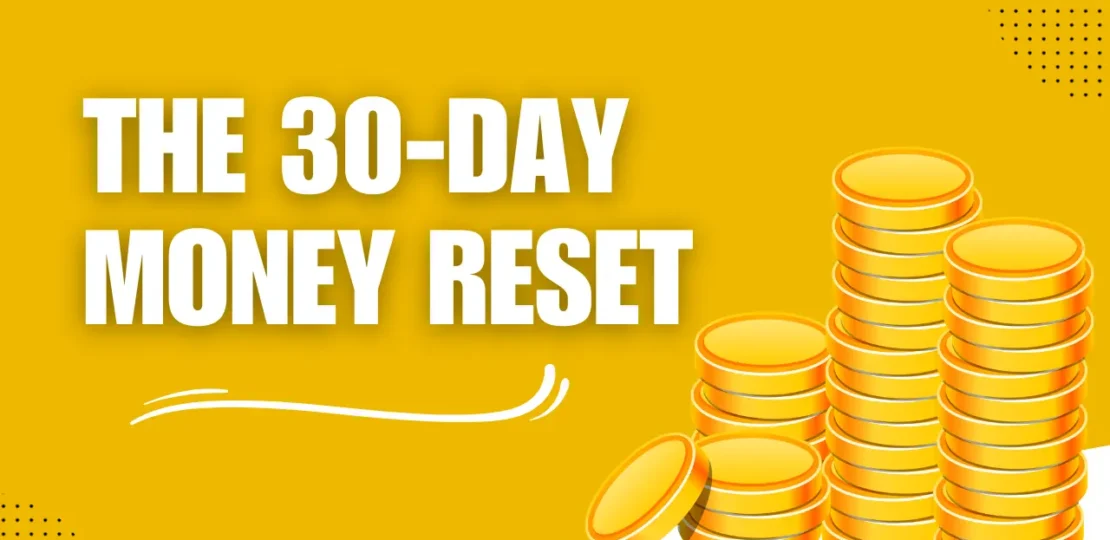🔄 The 30-Day Money Reset: Simple Steps to Get Your Finances Back on Track
August 26, 2025 | by Wellness World

Introduction
Money stress is one of the most common struggles today. Even if you earn a decent income, it often feels like your money slips away before the month ends. The problem isn’t always how much you earn — it’s usually how you manage what you already have.
That’s where the 30-Day Money Reset comes in. Think of it like hitting the “refresh” button for your finances. Just like people do a fitness detox or a digital detox, this is a financial detox that helps you take back control.
Over the next 30 days, you’ll build habits that:
✅ Show you exactly where your money goes
✅ Cut out waste without killing your lifestyle
✅ Build an emergency fund from scratch
✅ Get you started with investing
This isn’t about restriction — it’s about resetting your relationship with money so it works for you, not against you.
🗓️ Week 1: Awareness — Track Every Dollar
📌 Goal: Know exactly where your money is going.
Most people underestimate their spending. You might think you spend $200 a month on food delivery when in reality it’s $500. Awareness is the foundation of financial control.
How to Do It:
- Track every single expense for 7 days.
- Use apps like Mint, YNAB, Money Manager, or Walnut (India).
- Prefer pen & paper? Use a simple notebook or Google Sheets.
- Categorize your spending into 3 groups: Needs, Wants, and Leaks.
- Needs: Rent, groceries, bills.
- Wants: Entertainment, shopping, restaurants.
- Leaks: Things you forgot about or didn’t really need.
- Review at the end of the week → Where did the biggest chunk of money go?
Example:
- Rent: ₹15,000
- Groceries: ₹5,000
- Food Delivery: ₹7,200
- Subscriptions: ₹2,000
- Shopping: ₹3,500
👉 Just tracking might shock you — and that’s good. It’s the first step toward control.
✅ Checklist for Week 1:
- Download a tracker app
- Record every rupee/dollar spent
- Categorize into Needs/Wants/Leaks
🗓️ Week 2: Cut the Obvious Leaks
📌 Goal: Eliminate waste without sacrificing happiness.
Now that you know where your money goes, it’s time to clean up.
Common Money Leaks:
- Subscriptions you forgot about (streaming, apps, gyms).
- Bank fees (ATM charges, account maintenance).
- Food delivery habits (₹300/day = ₹9,000/month).
- Impulse shopping during online sales.
How to Fix Them:
- Subscriptions: Cancel at least 2 you don’t use. Example: If you have Netflix, Amazon Prime, and Disney+, pick 1–2 max.
- Bank Fees: Switch to a fee-free account or withdraw cash smartly.
- Food Delivery: Limit to weekends. Cook simple meals on weekdays.
- Impulse Buys: Use the 24-hour rule — add to cart but wait a day before buying.
💡 Savings Example:
- Cancel 2 subscriptions: ₹500/month = ₹6,000/year
- Cut delivery by 2 days/week: ₹2,400/month = ₹28,800/year
That’s ₹35,000/year saved just from this week.
✅ Checklist for Week 2:
- Cancel unused subscriptions
- Limit delivery & eating out
- Set alerts for fees/charges
🗓️ Week 3: Build a Starter Emergency Fund
📌 Goal: Have a financial safety net.
Life is unpredictable — a medical bill, job delay, or car repair can throw you off track. An emergency fund ensures you don’t fall into debt.
How to Start:
- Set a realistic target → Aim for ₹20,000–₹50,000 (or $300–$500) to begin.
- Open a separate savings account (preferably with higher interest).
- Automate savings: Transfer ₹100–₹200/day into this account.
- Quick cash hacks:
- Sell unused clothes/electronics.
- Use cashback apps like CRED, Paytm, Rakuten.
- Take a 7-day “no spend” challenge and save the difference.
💡 Math Example:
₹200/day × 30 days = ₹6,000 in one month, without noticing.
✅ Checklist for Week 3:
- Open emergency fund account
- Automate daily/weekly transfers
- Sell 3 unused items this week
🗓️ Week 4: Start Investing Small
📌 Goal: Make your money work for you.
Saving is great, but inflation eats into idle money. Investing grows it.
Beginner-Friendly Ways to Start:
- Index Funds/ETFs → Simple, low-cost, long-term.
- SIP (Systematic Investment Plan) in India → Start with ₹500–₹1,000/month.
- Robo-Advisors → Apps like Groww, Zerodha, Betterment, Wealthfront.
- Employer Plans → If you have PF/401k, increase contributions by 1–2%.
Golden Rule:
Start small but stay consistent. Even ₹1,000/month invested at 10% grows to over ₹2,00,000 in 10 years.
✅ Checklist for Week 4:
- Open an investment account/app
- Start with ₹500–₹1000 or $50
- Set auto-invest monthly
🎯 Bonus Habits for Long-Term Success
- Cash Envelope Method: Keep envelopes for groceries, eating out, etc. Once it’s empty, no more spending.
- No-Spend Days: Choose 2 days/week where you spend only on essentials.
- Mindful Spending Rule: Before every purchase, ask: “Do I need it, or do I just want it right now?”
🏆 Results After 30 Days
By the end of this reset, you’ll have:
✔️ Clear visibility of your spending
✔️ Cut ₹5,000–₹15,000 in leaks
✔️ Built an emergency fund starter
✔️ Invested your first ₹500–₹1000
That’s a lifetime financial upgrade in just 30 days.
Conclusion
The 30-Day Money Reset isn’t about punishment or extreme frugality. It’s about building awareness, cutting leaks, and creating a safety net while also setting up investments.
If you repeat this every quarter, imagine how much your savings, confidence, and peace of mind will grow.
So grab a notebook, mark your calendar, and start Day 1 today. Future-you will be grateful.
RELATED POSTS
View all

